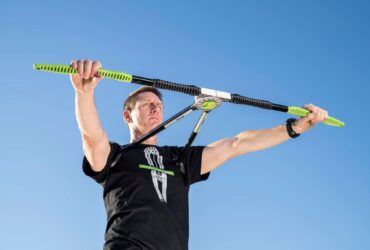In the world of precision measurement, rangefinders have carved an indispensable niche. Whether used in surveying, photography, ballistics or on the golf course, these devices help users measure distance with accuracy and confidence. In this comprehensive guide, we’ll explore:
- What a rangefinder is and how it works
- The history and evolution of rangefinding technology
- Different types of rangefinders (optical, laser, ultrasonic, etc.)
- Applications in golf (and other fields)
- What features to look for when buying a golf rangefinder
- Top models in 2025
- Pros, cons, and tips for use
- Frequently asked questions
By the end, beginners and experienced users alike will have a clearer understanding of how to choose, use, and benefit from rangefinders.
1. What Is a Rangefinder?
A rangefinder is a device that measures the distance from the observer to a target object. It does so by emitting or receiving signals (light, sound, radio, etc.) and computing the time or difference involved in signal reflection or triangulation. The output is typically a distance in meters or yards.
According to Wikipedia, a rangefinder may estimate distance by timing a returned signal (time-of-flight), or by measuring angles in a triangulation scheme.
In simpler terms: you point the rangefinder at a target (flag, tree, building), and it returns the distance — helping you decide how far your shot must travel, or how far a building is, or other distance‑based decisions.
2. A Brief History & Evolution
The concept of measuring distance is ancient. Over centuries, various techniques evolved, from simple pacing and estimating to mechanical and optical devices. A scholarly review “Ancient and modern rangefinders” details how early measurement tools gradually gave way to more precise instruments. arXiv
With the advent of optics in the 19th and 20th centuries, optical rangefinders (often used in cameras or military applications) became more common. The “coincidence rangefinder” uses two offset lenses and a focusing mechanism; when the two images align, the distance can be read. Wikipedia
Later, laser rangefinders revolutionized things. They emit a laser beam, wait for the reflection, and compute distance by the time-of-flight method (or other more advanced signal-processing methods). These are accurate, compact, and fast. The first recreational golf rangefinder, developed through a partnership between Laser Technology (LTI) and Bushnell Optics in 1994, marked the arrival of affordable, compact laser rangefinders for non‑industrial use. Laser Tech
Over time, electronic enhancements (such as slope compensation, image stabilization, digital displays, GPS integration, etc.) have made today’s rangefinders far more powerful than their early counterparts.
3. Types of Rangefinders & Their Working Principles
Here are the main categories and how they operate:
| Type | Principle / Method | Pros | Cons |
| Optical / Mechanical | Uses dual vision, prisms, mirrors, triangulation | No power needed, simple | Limited range, less precision, manual focusing |
| Laser (Optical) | Sends a laser pulse and times the reflection (or phase comparison) | Highly accurate, fast, compact | Dependent on line-of-sight, may be affected by weather or reflectivity |
| Ultrasonic / Sonar | Emits sound waves; measures echo time | Useful in short-range environments | Slower, low range, less precise, influenced by medium (air, water) |
| Radar / RF-based | Uses radio or microwave signals | Longer range, penetrates some obstructions | Bulkier, more complex electronics, costlier |
| Hybrid (laser + GPS / sensor fusion) | Combines laser distance measurement & GPS / topographic data | Versatile, informative, covers multiple use cases | More expensive, more complexity, higher power consumption |
In many consumer contexts—especially golf—the laser type is the gold standard because it offers the best balance of size, accuracy, speed, and user experience.
4. Rangefinders in Golf: Why They Matter
Golfers use rangefinders to precisely measure the distance from their current position to a target (e.g. the flag, hazard, or layup spot). This improves club selection, shot planning, and confidence. On many courses, subtle elevation changes, hazards, or slopes make judging distance visually error-prone.
From the GolfersHelp review site:
“Golf range finders help golfers measure distances accurately on the course. They enhance precision, improving your overall game performance.” www.golfershelp.com
And they note typical models include features such as slope measurement, GPS integration, and pin-seeking technology. www.golfershelp.com
Some users share how using a rangefinder significantly improved their scores:
“Using a range finder saved me 9 strokes.” Reddit
That said, it’s not a magic bullet—skill, wind, lie, and execution still matter. But the rangefinder eliminates one major source of guesswork: estimating distance.
5. Key Features to Look for in a Golf Rangefinder
When choosing a golf rangefinder, these features often distinguish a good device from an average one:
Accuracy & Range
- A good rangefinder should be accurate to within ±1 yard/meter (or better) under normal conditions.
- Maximum range (how far it can measure) matters if you sometimes need to lock onto distant objects (e.g., hazards) — typical values go up to 1,000+ yards. Golf Monthly+1
Magnification & Optics
- Magnification (e.g. 5×, 6×, 7×) helps you zoom in on small or distant targets.
- Quality lenses, coatings, and clarity help in low light or contrast conditions.
Slope / Elevation Compensation
- Many rangefinders can adjust the measured distance to account for uphill or downhill slopes (i.e., the “effective” distance).
- However, in many tournaments (especially at higher levels), slope mode is disallowed — so the ability to toggle slope on/off is a desirable feature. www.golfershelp.com+2Critical Golf+2
Pin-Seeking / Flag-Lock Technology
- This helps focus on and “lock onto” the flagstick (rather than background objects). It can involve vibration, audio or visual cues. www.golfershelp.com+2Golf Monthly+2
Display, Interface & Usability
- Easy-to-read displays (LED, OLED, black-on-white)
- One-button operation
- Speed / reaction time to measurement
- On/off toggles for slope mode, metrics, scanning modes
Build Quality / Durability
- Water or dust resistance (IP ratings)
- Shock resistance
- Solid casing and grips
Battery & Power
- Some use replaceable batteries (e.g. CR2)
- Others use rechargeable lithium-ion
- Battery life (number of readings per charge or battery) is important in long rounds
Additional Features
- Scan Mode: measure continuously over a sweep (e.g. along tree line)
- Magnetic Mount / Clip: attach to a cart, bag
- GPS integration or course maps (in hybrid models)
- App connectivity / Bluetooth
- Feedback (vibration / audio / beep)
When shopping, balance features against cost and your actual needs (do you really need all bells and whistles?).
6. Top Golf Rangefinders in 2025 (Based on Reviews)
Based on recent comparative reviews and buyer guides, here are some standout rangefinders in 2025:
| Category | Model | Why It Stands Out |
| Best Overall / All-Rounder | Bushnell Tour V6 Shift | Excellent optics, high accuracy, solid package (Golf Monthly) Golf Monthly |
| For Accuracy / Premium | Bushnell Pro X3+ | Adds advanced features like slope, app connectivity Golf Monthly |
| Value / Best Bang for Buck | BlueTees Series 3 Max, Gogogo GS-24 | Affordable options with solid features (CriticalGolf) Critical Golf |
| Compact / Lightweight | Bushnell Tour V5 | Easy to carry, good performance for everyday play (Golf.com) Golf |
| Budget Friendly | GolfBuddy Laser Lite 2 | Lightweight, slope-enabled, good overall value Golf Monthly |
These models reflect current trends: better optics, easier interface, faster processing, and more intelligent algorithms for pin detection, slope compensation, and app integration.
7. Pros & Cons — When a Rangefinder Helps (and When It Doesn’t)
Advantages
- Eliminates Distance Guessing: Gives precise yardage, removing one big variable from your decision-making.
- Better Club Selection: With accurate distance, you can choose clubs more confidently (especially for mid- to long-range shots).
- Faster Play: Rather than pacing or consulting a course map, a quick laser reading speeds up decisions.
- Improves Strategy: Knowing distances to hazards or layup zones helps you plan safer routes.
- Confidence Booster: When you know the number, you can focus more on execution.
Limitations & Challenges
- Line-of-Sight Required: You need a clear path to the target; thick foliage, giants, or obstacles may block the beam.
- Reflectivity & Conditions: Bright sunlight, low contrast, or highly reflective targets can reduce accuracy.
- Battery Limits: If your battery dies mid-round, you’re left without the tool.
- Rules / Tournament Restriction: As noted earlier, slope mode is often disallowed in official tournaments — so your device should allow toggling features.
- Over-reliance Risk: You must still consider wind, lie, shot shape, and execution; knowing distance is just one part of the puzzle.
- Cost & Value: High-end models can be pricey; at some point, diminishing returns set in.
In user forums, some golfers swear by their rangefinders; others say once the device fails or battery dies, they revert to old estimation habits. Reddit+2Reddit+2
A thoughtful user comment:
“A rangefinder without pin lock or slope is nearly useless… the fairway stakes will give you the same info, if not even more accurately.” Reddit
That highlights how complementary features (pin lock, slope) often make the difference between “meh” and genuinely useful.
8. How to Use a Rangefinder in Golf: Best Practices & Tips
To get the most out of your rangefinder, follow these tips:
- Aim Carefully: Hold steady, aim at the top of the flagstick or target point, press and wait for the lock.
- Use Pin-Seeking Mode: Activate pin-lock to help ignore background targets.
- Toggle Slope When Needed: In casual play, slope mode is great; but before tournament play, ensure it’s turned off if needed.
- Scan / Sweep: Use scan mode when measuring distances across features (e.g. along a row of trees).
- Practice Reading Off the Range: At the driving range, use markers and known-distance flags to calibrate your feel vs. the digital reading.
- Mind the Environment: On hazy or rainy days, results may vary — aim for high-contrast or reflective surfaces.
- Verify With Course Info: Use yardage markers, course maps, or GPS as cross-checks.
- Preserve Battery: Turn it off when not in use; carry spare batteries or a charger.
- Maintain Clean Lens: Dust, smudges, or fingerprints degrade performance. Use microfiber cloths.
- Practice Without It: Don’t become over-reliant — continue to hone estimating skills for the “just in case” scenario.
9. SEO Considerations & Keywords (for Your Blog)
To optimize this article for search engines, here are suggested keyword targets and structural ideas:
- Primary keywords: “golf rangefinder,” “rangefinder review,” “best rangefinder 2025,” “laser rangefinder for golf”
- Secondary / long-tail keywords: “slope rangefinder toggle off,” “pin-seeking rangefinder comparison,” “how to choose golf rangefinder,” “rangefinder accuracy ±1 yard,” “rangefinder vs GPS golf”
- Heading structure (H1–H3): Use keyword-rich headings (e.g. “Best Golf Rangefinder Models 2025,” “Rangefinder Features: Slope, Pin-Lock and More”)
- Internal linking: Link to related posts (e.g. “Top Golf Gadgets,” “GPS vs. Laser in Golf”)
- Image alt-texts: Use phrases like “golf laser rangefinder close-up,” “golfer using rangefinder,” “rangefinder slope display”
- Schema / Rich snippets: Consider review schema for top models, FAQ schema for common questions
- Meta description (150–160 characters): e.g. “Discover the features, types, top models, and buying tips for golf rangefinders in 2025 – find the best laser device for your game.”
10. Frequently Asked Questions (FAQs)
Q1: Are rangefinders allowed in professional tournaments?
In many official tournaments, the use of slope or elevation‑compensating features is disallowed; only “plain distance” mode is often permitted. Some tournament organizers outright ban rangefinders. Always check the local rules.
Q2: Rangefinder vs GPS — which is better?
GPS gives distance to front/back of green, hazards, and helps with course mapping. But it may lack precise “to-flag” reading, especially for intermediate targets. Laser rangefinders give pinpoint accuracy. Some hybrid models combine both.
Q3: How accurate is a good rangefinder?
Under favorable conditions, accuracy is typically ±1 yard (or better). But real-world variances (slope, reflectivity, weather) can introduce small deviations.
Q4: Can slope mode be toggled off?
Yes — many quality rangefinders allow you to switch slope adjustment on/off (important for tournament compliance).
Q5: How much should I spend?
You can find decent beginner models for under USD 100–150, but for premium optics, fast pin-lock, and advanced features, prices can go several hundred dollars. Balance your budget with features you’ll actually use.
Q6: How long does a rangefinder last?
With typical use and good care, many last years. Battery replacements or charging may be the limiting factor. Build quality (weather sealing, materials) plays a big role.
Conclusion
Rangefinders represent a major leap forward from visual estimation. In golf, they provide a valuable tool for accuracy, strategy, and confidence. Whether you’re a casual player or a serious competitor, understanding the technology, features, and trade-offs will help you choose a model that elevates your game.
If I were to summarize in one sentence: A well-chosen golf rangefinder can reduce guesswork, improve club selection, and become an indispensable companion on the course.




Leave a Reply